Customer Satisfaction Metric
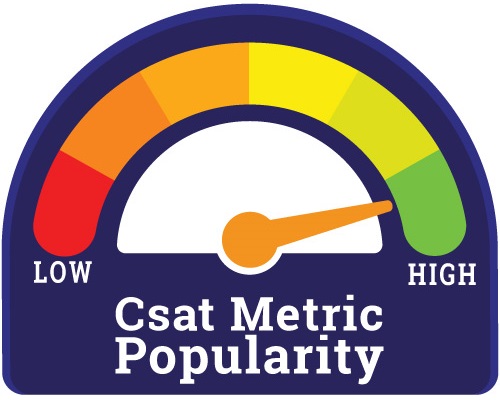
The Customer Satisfaction (Csat) metric is still the most popular call center metric for measuring and managing Customer Experience (CX) we have. The Csat metric is popular because it is broadly understood, researched, and easy to communicate to stakeholders. In addition, the Csat metric is considered the best metric for quantifying how satisfied customers are with their call center experience for resolving their call reason.
Moreover, the Csat is expressed as a score derived from a post-call customer satisfaction survey question. Csat is a measurement of satisfaction at a given point in time. For example, after a customer interacts with a call center. Csat insights help pinpoint issues or achievements with a customer journey interacting with a call center.
The Csat metric provides call center analysts, managers, and agents with the voice of the customer (VoC) feedback based on post-call surveys on how satisfied they are with the service they experienced. In addition, the Csat VoC feedback provides insights for improving people, processes, policies, and technologies to deliver great customer service.
To ensure that the Csat metric accurately assesses how satisfied customers interact with a call center, it needs to use high-quality survey methodologies. For example, a good Csat survey question and rating design, post-call surveys conducted within one business of the interaction, avoidance of survey bias, high response rates, surveying the right callers, and using open-ended questions to determine why Csat is low or high.
Furthermore, you need to understand the Csat feedback, share it with the stakeholders, and most importantly, take action internally and externally to improve customer experience continuously. If you don't take action to improve Csat, you are wasting the company's money, employees' and customers' time.
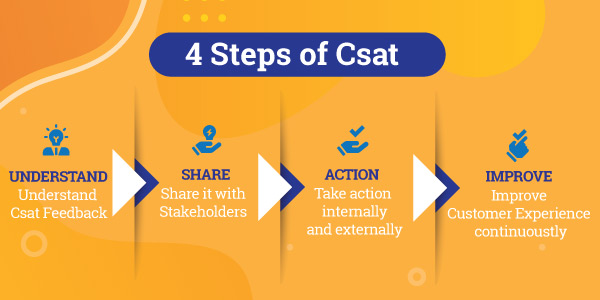
First Call Resolution (FCR) is the most important driver for high Csat. SQM Group research shows that for every 1% improvement in FCR, there is a 1% improvement in customer satisfaction. In turn, the Csat metric is a driver for customers wanting to refer a company to others, willing to buy more products and services from the company, and continue to do business with a company.
What is a Good Customer Satisfaction Score?
The Csat score or rate is commonly expressed as a percentage of a top box or top two boxes survey response. On a 4 or 5-point Csat scale, that usually means customers that responded with a top box rating response (e.g., very satisfied). The Csat percentage is calculated by dividing the number of very satisfied customers by the total number of customers who participated in the survey, then multiplying that result by 100. The closer that Csat score approaches 100%, the better.
SQM's Csat research shows the Call Center Industry average Csat (top box response) benchmark score is 78%. The Csat benchmark score means that 78% of customers are very satisfied with the call center's customer service. The call center industry standard for a good Csat score is 75% to 84%. The World-class Csat score is 85% or higher, and only 5% of call centers can achieve the World-class Csat score.
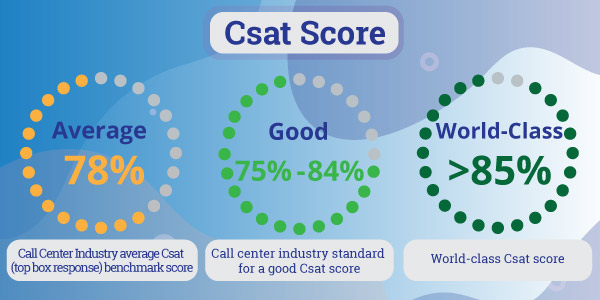
Customer Satisfaction Measurement
As the old saying goes, you can't improve what you don't measure and can't measure what you can't define. Therefore, the Csat metric is a must if you want to measure a call center's customer service. In addition, there are many call center Csat questions and scales to measure Csat.
At SQM, we use the top box Csat rating (e.g., very satisfied) response for measuring call center CX. For example, we use the top box Csat rating response to measure benchmark performance and determine CX opportunities. Put simply, any Csat rating less than the top box survey response is an opportunity to improve CX.
At SQM, we use the below two questions to measure, track, benchmark, and award to help clients improve call center and agent Csat.
Call Center Csat Question:

Based on your last call to XYZ Company, overall how satisfied are you with their call center? Would you say you are... *
- Very satisfied
- Satisfied
- Neutral
- Dissatisfied
- Very dissatisfied
Agent Csat Question:
Overall, how satisfied are you with the customer representative who handled the call? Would you say you are... *
- Very satisfied
- Satisfied
- Neutral
- Dissatisfied
- Very dissatisfied
* For the Csat questions, most SQM clients use a 4 or 5 points Csat labeled survey scale. However, your Csat survey scale can be 1 – 4, 1 – 5, 1 – 7, or 1 – 10, and there's no universal agreement on which Csat scale method is best to use.
Two different types of surveys were used to measure and improve Csat: transactional survey and relationship survey.

Transactional surveys are triggered (within one day) after using a call center. They provide insights for Csat with a call center. Furthermore, they generate tactical information for making call center CX improvements. Post-call transactional surveys conducted within one day using phone, IVR, and email are the best survey approaches for measuring call center Csat. Moreover, the closer a post-call survey is conducted to the CX, the better.
Relationship surveys are sent at regular and predefined intervals. They provide insights into Csat with the overall relationship and brand. Moreover, they generate strategic information to decide which business areas need to improve CX. However, relationship surveys are ineffective for accurately assessing call center Csat because a recent call center interaction does not trigger the survey.
What is the Best Call Center CX Metric?
The question of the best call center CX metric is very subjective. However, in a recent poll that we conducted with mostly non-SQM Group clients, the Csat metric was considered the best call center CX metric by 40% of survey participants, which is the highest among the key CX metrics.
However, when we conducted a poll about the best call center CX metric among our clients, the FCR metric had the highest ranking, followed closely by the Csat metric. It is SQM's view that FCR and Csat are the two most important call center CX metrics, with FCR being the king of all call center metrics because FCR is the leading indicator of Csat. Most SQM clients use FCR and Csat metrics as the primary CX goal metrics and for employee accountability.
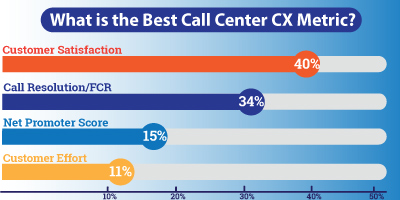
Many call center employees (e.g., agents, supervisors, leaders) dislike being held accountable for transactional NPS. In addition, call center employees dislike the NPS metric for CX accountability because they believe they have limited or no control over company policies, pricing, products, and services.
Furthermore, in many cases, agents and supervisors believe that they have more control over Csat, and if they provide high Csat, it would positively impact transactional NPS. The Csat metric is SQM Group's clients' most popular CX metric used at all levels (e.g., agents to SVP) within the call center function for CX goals, creating accountability, and measuring performance.
Why the Call Center Csat Metric is Popular
Determining customer service delivery is difficult without measuring Csat. Therefore, most call centers measure Csat because they feel letting customers judge their service is the most accurate way to measure and improve customer service. In addition, many call centers committed to delivering great CX or improving CX use a VoC closed-loop improvement process for developing a Csat action plan.
When we ask interviewees (e.g., survey participants) and interviewers (e.g., telephone survey reps) what is the most important call center CX survey question we ask, the Csat metric is considered the most valuable. The reason interviewees like the Csat question is it is easy to understand and a relevant question to rate their call center customer experience. Moreover, survey interviewees like to share feedback on why they are satisfied or dissatisfied with their call center CX.
Another reason why the Csat is popular is that enlighted leaders understand call center Csat and its impact on the business is essential. For example, many people think that price is the main reason customers defect; however, in most cases, it's poor customer service. Furthermore, it is well-accepted that it costs companies at least five times more to attract a new customer than to retain an existing one. Listed below are the benefits of achieving high Csat and the main reasons Csat is the most popular metric for measuring call center CX.
Here are Five Benefits of Achieving Call Center Csat:
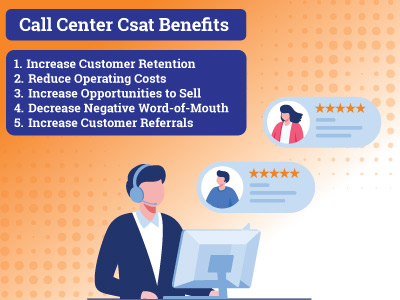
- Increase Customer Retention
95% of customers will continue to do business with a company because they are very satisfied with their call center CX.
- Reduce Operating Costs
For every 1% improvement in Csat (e.g., top box survey response – very satisfied), you reduce your call center operating costs by 1%.
- Increase Opportunities to Sell
When a customer is very satisfied, the cross-selling acceptance rate increases by 20% due to the agent earning the right sell.
- Decrease Negative Word-of-Mouth
75% of customers who are very dissatisfied with their call center experience will tell three people about their poor customer experience.
- Increase Customer Referrals
When the Csat score is high or low, so are customer referrals. For example, every 1% improvement in the Csat score increases interactional NPS® by 1.4 points.
Quick Related Links
First Call Resolution Comprehensive Guide FCR Case Study Top 10 Cal Center Metrics VoC Closed-Loop Outside-In or Inside-Out Journey Mapping Sample Size Calculator Good to Great Customer Service CSM Software Customer Satisfaction Comprehensive Guide
